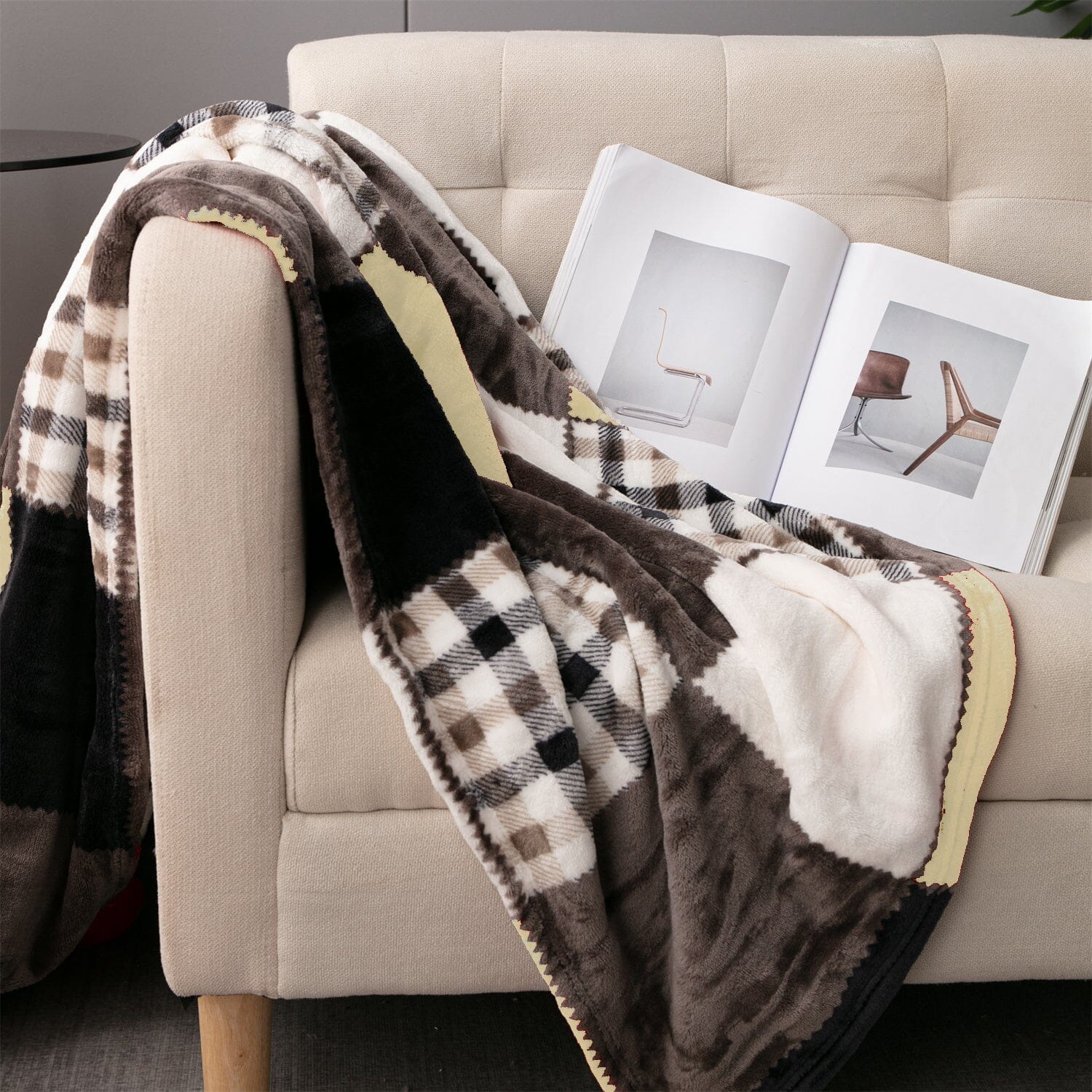When it comes to selecting a blanket, one of the most critical factors to consider is the material used to make it. Different materials have distinct properties that can impact a blanket's overall quality, comfort, and durability.
Here are some of the best materials for a blanket, along with their pros and cons:
Cotton
Cotton blankets are a good choice for those who want a durable and comfortable blanket that is suitable for year-round use. However, those looking for a more luxurious or warm option may want to consider other materials.
- Cotton is a versatile and widely used material that is soft and breathable, making it comfortable for all seasons.
- Relatively affordable and easy to find in a variety of colors and patterns.
- Natural material that is hypoallergenic, making it a good choice for people with allergies or sensitive skin.
- Durable and can withstand frequent washing without losing their shape or color.
- Cotton can be prone to pilling, which can make them look worn or fuzzy over time.
- Not as warm as some other materials, so it may not be the best choice for very cold climates or winter months.
- Some cotton blankets may shrink or wrinkle after washing, so it's important to follow care instructions carefully.
- Not as soft as some other materials, such as cashmere or faux fur, so it may not provide the same level of luxurious comfort.
Wool

Wool blankets are a great choice for those who want a warm, durable, and eco-friendly option for winter use. However, those with sensitive skin or a smaller budget may want to consider other materials. It's also important to keep in mind the special care requirements for wool blankets to ensure they last a long time.
- Wool is a natural insulator that is warm and cozy, making it ideal for use in colder climates or during the winter months.
- Durable material that can withstand wear and tear, making it a good investment for long-term use.
- Naturally flame-resistant and moisture-wicking, which can help prevent fires and keep you dry and comfortable.
- Sustainable and eco-friendly material, making it a good choice for those who prioritize environmental sustainability.
- Wool can be expensive, especially for high-quality or specialty types of wool such as alpaca or merino.
- Some people may find wool blankets to be itchy or irritating to the skin.
- It can be heavy and bulky, which may make it less convenient for travel or storage.
- Requires special care when washing and drying to avoid shrinkage or damage, which can be time-consuming and inconvenient.
Fleece
Fleece blankets are a great choice for those who want a lightweight and affordable option for warmth and comfort. However, those looking for a more durable or natural option may want to consider other materials. It's also important to keep in mind the potential drawbacks of fleece blankets, such as their lack of breathability or durability.
- Fleece is a soft and lightweight material that provides warmth and comfort, making it a popular choice for blankets.
- Affordable and widely available in many different colors, patterns, and sizes.
- It is a synthetic material that is hypoallergenic and does not shed, making it a good choice for people with allergies or asthma.
- Machine-washable and dries quickly, making it easy to care for and maintain.
- Fleece is not as durable as some other materials and can pill or wear out over time with frequent use or washing.
- Not as breathable as natural materials like cotton or wool, which can make it uncomfortable in warmer weather.
- Some people may find fleece blankets to be too synthetic or artificial-feeling, which can detract from their comfort.
Cashmere

Cashmere blankets are an excellent choice for those who prioritize comfort, luxury, and warmth. However, they may not be the best choice for those with a limited budget or who do not want to invest time and effort into their care and maintenance. It's also important to keep in mind the potential drawbacks of cashmere blankets, such as their cost and delicate nature, when considering them as an option.
- Cashmere is a luxurious and ultra-soft material that provides unparalleled comfort and warmth.
- Lightweight and breathable, making them ideal for use in all seasons.
- Hypoallergenic and gentle on the skin, making it a good choice for people with allergies or sensitive skin.
- It is a durable material that can last a long time with proper care and maintenance.
- Cashmere is an expensive material, which can make cashmere blankets a luxury item that is not affordable for everyone.
- Requires special care and attention when washing and drying, which can be time-consuming and inconvenient.
- It is a delicate material that can be prone to damage or pilling with frequent use or washing.
- May not be as readily available as other materials, which can make it harder to find in certain styles or colors.
Silk

Silk blankets are a great choice for those who prioritize comfort, luxury, and breathability. However, they may not be the best choice for those with a limited budget or who do not want to invest time and effort into their care and maintenance. It's also important to keep in mind the potential drawbacks of silk blankets, such as their cost and delicate nature, when considering them as an option.
- Silk is a lightweight and breathable material that provides a comfortable and luxurious feel.
- They are hypoallergenic and gentle on the skin, making them a good choice for people with allergies or sensitive skin.
- Durable material that can last a long time with proper care and maintenance.
- Natural temperature-regulating properties, making it suitable for use in all seasons.
- Silk is an expensive material, which can make silk blankets a luxury item that is not affordable for everyone.
- Requires special care and attention when washing and drying, which can be time-consuming and inconvenient.
- It is a delicate material that can be prone to damage or staining with frequent use or washing.
- They may not provide as much warmth as other materials, making them less suitable for colder climates or winter use.
Faux fur
Faux fur blankets are a great choice for those who want a luxurious and cozy feel without the ethical concerns of real fur. They are typically less expensive than real fur, easy to care for, and durable. However, they may not be the best choice for those who prioritize breathability or warmth, or who do not like the look or feel of synthetic materials. It's important to keep these potential drawbacks in mind when considering faux fur blankets as an option.
- Faux fur blankets provide a luxurious and cozy feel, similar to real fur, but without ethical concerns.
- Typically less expensive than real fur, making it a more affordable option for those who want a similar look and feel.
- It is a durable material that can last a long time with proper care and maintenance.
- they are typically easy to care for and can be machine-washed.
- Some people may find faux fur blankets to be less breathable than other materials, which can make them less comfortable in warmer weather.
- It may not provide as much warmth as other materials, such as wool or cashmere, making them less suitable for colder climates or winter use.
- It may shed over time with frequent use or washing, which can detract from their appearance and quality.
- Some people may not like the look or feel of faux fur, as it can be seen as artificial or synthetic.
Sherpa
Sherpa blankets are a great choice for those who prioritize comfort and coziness. They are typically lightweight, breathable, and easy to care for. However, they may not be the best choice for those who prefer natural materials, need a lot of warmth and insulation, or do not like the look or feel of synthetic materials. It's important to keep these potential drawbacks in mind when considering sherpa blankets as an option.
- Sherpa blankets are extremely soft and comfortable, providing a cozy and warm feel.
- They are typically lightweight and breathable, making them suitable for use in all seasons.
- Easy to care for and can be machine-washed.
- Often made with synthetic materials, making them a more affordable option compared to natural materials such as wool or cashmere.
- Some people may find sherpa blankets to be too warm or heavy for their liking, particularly in warmer weather.
- Sherpa blankets may shed over time with frequent use or washing, which can detract from their appearance and quality.
- May not provide as much insulation as other materials, such as wool or down, making them less suitable for use in very cold climates or for winter use.
- Some people may not like the look or feel of synthetic materials, which can be a common component of sherpa blankets.
Tapestry
Tapestry blankets are a great choice for those who want to add visual interest and style to a room. They are typically made from high-quality materials and can be used as both a decorative piece and as a functional blanket. However, they may not be the best choice for those who prioritize warmth, comfort, or practicality. It's important to keep these potential drawbacks in mind when considering tapestry blankets as an option.
- Tapestry blankets are often made from high-quality materials, such as cotton or wool, providing a soft and durable feel.
- They often feature unique and intricate designs, making them a great way to add visual interest and style to a room.
- It can be used as both a decorative piece and as a functional blanket.
- They can be machine-washed, making them easy to care for.
- Tapestry blankets may not be as warm or cozy as other materials, such as wool or fleece.
- May not be as soft or comfortable as other materials, such as cashmere or silk.
- May not be suitable for use as a primary bedding option, as they may not provide enough warmth or insulation.
- Some people may not like the look or feel of tapestry blankets, which can be seen as decorative rather than functional.
When selecting a blanket material, it's important to consider your personal preferences and needs. Factors such as climate, budget, and desired level of softness and warmth should all be taken into account. Ultimately, the best material for a blanket is one that meets your needs and provides comfort and satisfaction for years to come.






